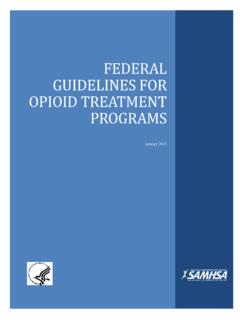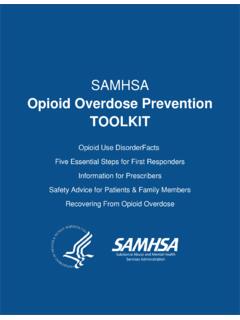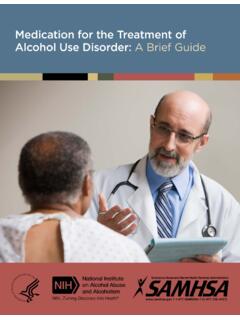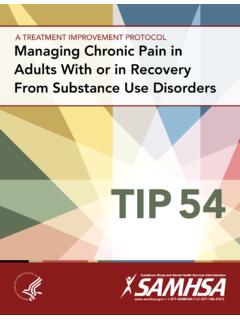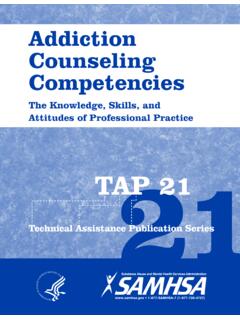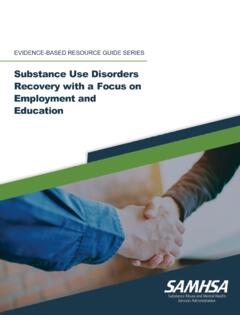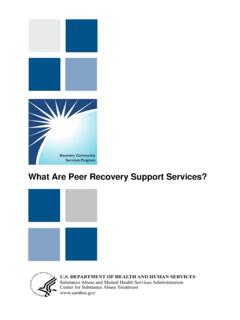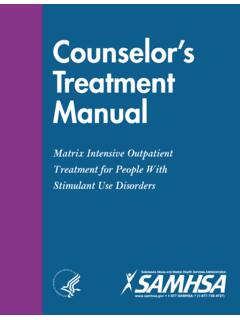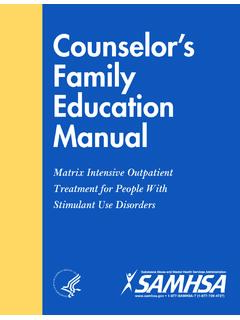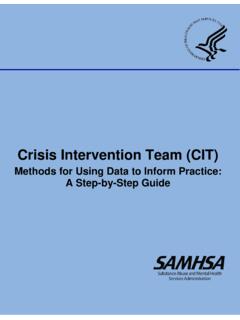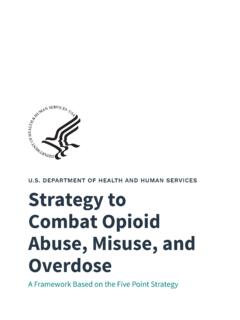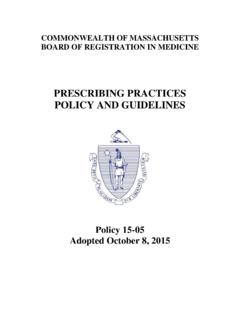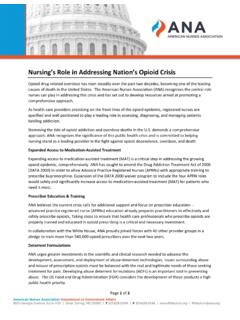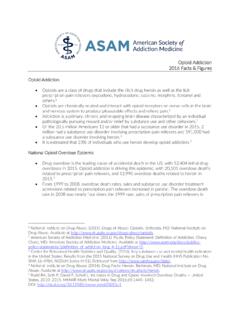Transcription of TIP 63: Medications for Opioid Use Disorder
1 UPDATED 2021 Medications for Opioid Use Disorder For Healthcare and Addiction Professionals, Policymakers, Patients, and Families TREATMENT IMPROVEMENT PROTOCOL TIP 63 Please share your thoughts about this publication by completing a brief online survey at: The survey takes about 7 minutes to complete and is anonymous. Your feedback will help SAMHSA develop future products. Medications FOR Opioid USE DISORDERTIP 63 Treatment Improvement Protocol 63 For Healthcare and Addiction Professionals, Policymakers, Patients, and Families This TIP reviews three Food and Drug Administration-approved Medications for Opioid use Disorder treatment methadone, naltrexone, and buprenorphine and the other strategies and services needed to support people in recovery.
2 TIP Navigation Executive Summary For healthcare and addiction professionals, policymakers, patients, and families Part 1: Introduction to Medications for Opioid Use Disorder Treatment For healthcare and addiction professionals, policymakers, patients, and families Part 2: Addressing Opioid Use Disorder in General Medical Settings For healthcare professionals Part 3: Medications for Opioid Use Disorder For healthcare professionals Part 4: Bringing Together Addiction Treatment Counselors, Clients, and Healthcare Professionals For healthcare and addiction professionals Part 5: Resources Related to Medications for Opioid Use Disorder For healthcare and addiction professionals, policymakers, patients, and families ii TIP 63 Medications FOR Opioid USE Disorder PART 1: INTRODUCTION TO Medications FOR Opioid USE Disorder TREATMENT Contents EXECUTIVE SUMMARY Foreword.
3 ES-iii TIP 63 Update ..ES-iii Introduction ..ES-1 Overall Key Messages ..ES-1 Content Overview ..ES-3 Notes ..ES-7 TIP Development Publication Information .. ES-12 The Approach to OUD Care ..1-1 Overview of Medications for OUD ..1-3 Duration of Treatment With OUD Treatment Settings ..1-9 Challenges to Expanding Access to OUD Resources ..1-10 Notes ..1-11 PART 2: ADDRESSING Opioid USE Disorder IN GENERAL MEDICAL SETTINGS Scope of the Problem ..2-1 Screening ..2-1 Assessment ..2-8 Treatment Planning or Referral ..2-17 Resources ..2-28 Appendix ..2-32 Notes ..2-39 iii Medications FOR Opioid USE Disorder TIP 63 PART 3: Medications FOR Opioid USE Disorder Scope of the Problem.
4 3-1 Chapter 3A: Overview of Medications for Opioid Use Disorder ..3-5 Chapter 3B: Chapter 3C: Naltrexone ..3-37 Chapter 3D: Buprenorphine ..3-51 Chapter 3E: Medical Management Strategies for Patients Taking OUD Medications in Ofce-Based Chapter 3F: Medical Management of Patients Taking OUD Medications in Hospital Settings ..3-103 Notes ..3-109 PART 4: BRINGING TOGETHER ADDICTION TREATMENT COUNSELORS, CLIENTS, AND HEALTHCARE PROFESSIONALS Overview and Context ..4-1 Quick Guide to Counselor Prescriber Communications ..4-18 Creation of a Supportive Counseling Experience ..4-20 Other Common Counseling Concerns ..4-34 Notes ..4-37 PART 5: RESOURCES RELATED TO Medications FOR Opioid USE Disorder General Resources.
5 5-1 Resources for Counselors and Peer Providers ..5-10 Resources for Clients and Families ..5-12 Provider Tools and Sample Forms ..5-16 Glossary of TIP Terminology ..5-56 Notes ..5-59 This page intentionally left blank. Medications FOR Opioid USE DISORDERTIP 63 Substance Abuse and Mental HealthServices Administration Executive Summary For Healthcare and Addiction Professionals, Policymakers, Patients, and Families The Executive Summary of this Treatment Improvement Protocol provides an overview on the use of the three Food and Drug Administration-approved Medications used to treat Opioid use Disorder methadone, naltrexone, and buprenorphine and the other strategies and services needed to support recovery.
6 TIP Navigation Executive Summary For healthcare and addiction professionals, policymakers, patients, and families Part 1: Introduction to Medications for Opioid Use Disorder Treatment For healthcare and addiction professionals, policymakers, patients, and families Part 2: Addressing Opioid Use Disorder in General Medical Settings For healthcare professionals Part 3: Medications for Opioid Use Disorder For healthcare professionals Part 4: Bringing Together Addiction Treatment Counselors, Clients, and Healthcare Professionals For healthcare and addiction professionals Part 5: Resources Related to Medications for Opioid Use Disorder For healthcare and addiction professionals, policymakers, patients, and families ES-ii TIP 63 Medications FOR Opioid USE Disorder Executive Summary Contents Foreword.
7 ES-iii TIP 63 Update ..ES-iii Introduction ..ES-1 Overall Key Messages ..ES-1 Content Overview ..ES-3 Part 1: Introduction to Medications for Opioid Use Disorder Treatment ..ES-3 Part 2: Addressing Opioid Use Disorder in General Medical Settings ..ES-4 Part 3: Medications for Opioid Use Part 4: Bringing Together Addiction Treatment Counselors, Clients, and Healthcare Professionals ..ES-5 Part 5: Resources Related to Medications for Opioid Use Notes ..ES-7 TIP Development Expert Panelists ..ES-9 Scientific Reviewers ..ES-10 Field Publication Information .. ES-12 ES-iii TIP 63 Executive Summary Foreword The Substance Abuse and Mental Health Services Administration (SAMHSA) is the Department of Health and Human Services agency that leads public health efforts to reduce the impact of substance abuse and mental illness on America s communities.
8 An important component of SAMHSA s work is focused on dissemination of evidence-based practices and providing training and technical assistance to healthcare practitioners on implementation of these best practices. The Treatment Improvement Protocol (TIP) series contributes to SAMHSA s mission by providing science-based, best-practice guidance to the behavioral health field. TIPs reflect careful consideration of all relevant clinical and health services research, demonstrated experience, and implementation requirements. Select nonfederal clinical researchers, service providers, program administrators, and patient advocates comprising each TIP s consensus panel discuss these factors, offering input on the TIP s specific topics in their areas of expertise to reach consensus on best practices.
9 Field reviewers then assess draft content and the TIP is finalized. The talent, dedication, and hard work that TIP panelists and reviewers bring to this highly participatory process have helped bridge the gap between the promise of research and the needs of practicing clinicians and administrators to serve, in the most scientifically sound and effective ways, people in need of care and treatment of mental and substance use disorders. Department of Health and Human Services Substance Abuse and Mental Health Services Administration TIP 63 Update As a reflection of SAMHSA s commitment to ensuring that people with substance use disorders receive timely, relevant, high-quality care, SAMHSA in May 2021 revised certain areas of all five parts of this TIP to bring the content up to date and make it as useful to readers as possible.
10 These changes will help provide readers with the latest information needed to understand Medications for Opioid use Disorder . These changes include the following: Updating statistics from SAMHSA, the Centers for Disease Control and Prevention, and other health authorities on Opioid -related deaths, overdoses, accidents, and hospitalizations. Updating the qualifications of practitioners who are eligible to apply for a waiver to prescribe buprenorphine ( , clinical nurse specialists, certified registered nurse anesthetists, and certified nurse midwives) to include exceptions under the latest buprenorphine practice guidelines on obtaining a waiver. Where needed, clarifying whether references to naltrexone refer to the oral formulation or the extended-release injectable formulation.
